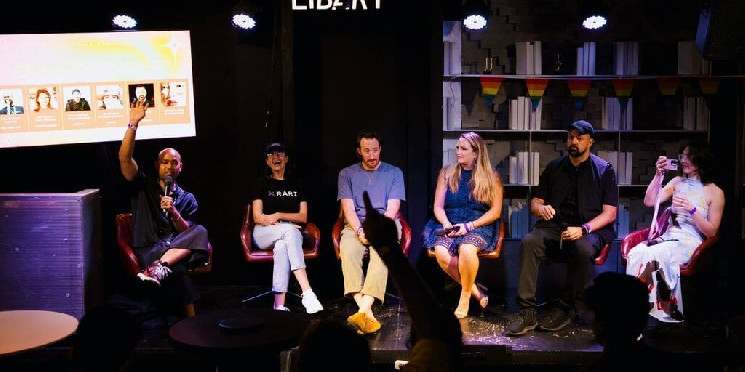Non-fungible tokens (NFTs) are evolving to create more “value and usability” for their creators and users, according to a recent panel discussion on “Navigating the Evolving NFT Landscape” at the TEN by RARI x Refraction event in Bangkok.
While the creative economy is the “flagship use case” of consumer and retail NFTs, “there will be many other uses of NFTs that are only on the backend,” says Jana Bertram, head of strategy at the RARI Foundation. Rug Radio maker Pukerainbow.
DevCon was optimal for catching up and hearing from the community and industry leaders about crypto, NFTs and market trends
Here’s the TL;DR of our panel: The Current State of NFTs with @rarible @arbitrum @JustinGilanyi @shavonnewong_ and @pukerrainbrow
with link to full… pic.twitter.com/PY12ahqZoP
— RARI Chain (@RariChain) November 18, 2024
Users won’t know that NFTs power the application, she said, adding that “nobody cares — it’s just something that functions, but it will be powered by those NFTs.” She pointed to the RARI Protocol’s integration with multiple ecosystems and chains, adding that “this tech stack can fuel NFT growth across all these different ecosystems.”
From speculation to impact-driven NFTs
As the technology underlying NFTs evolves, so do NFTs themselves, offering “different kinds of mechanics that you can play with,” says new media artist Shavonne Wong. Justin Gilanyi, curator at Codex Projects added that dedicated NFT artists, fashion designers and musicians have been working during the crypto bear market to “build their craft, learn their tools and really develop their concepts.”
Creators are experimenting with the new tools at their disposal to add “meaning and story” to their NFTs, Bertram said. “You can then think about community and using NFTs as an engagement mechanism,” she added.
Sam Friedman, head of marketing at Arbitrum, pointed to a recent example where users could “burn an NFT and then get a piece of physical merchandise, if that’s what you want.” Another emerging use case is to “link an NFT to someone, and then you can use that as a mechanism to then send subsequent information to that wallet address,” he said.
Training makers
There are still “hurdles and barriers to overcome for mass adoption,” Gilanyi said, with Friedman adding, “Education and distribution are the things we really need to work on, especially in the creator space.”
That education should include a broader view of Web3, beyond just minting NFTs or earning royalties on secondary sales, Bertram said. She explained that RARI “brings creators on board” for decentralized finance (DeFi), so they can “experience a bit of a different angle in Web3” and learn new ways to monetize their skills, such as staking and yield farming. To this end, RARI has launched workshops in locations around the world, including Lagos, Bangkok, Lisbon and New York, to connect with NFT creators and educate them on the broader capabilities of Web3.
NFTs are about much more than just art, the panel argued, allowing creators to build deeper connections with audiences. “We have artists who not only create art, but also create experiences, create activations and create content,” Gilanyi said.
“Creator first” innovations
Traditional artists are increasingly drawn to the technology, thanks to creator-first innovations such as royalties embedded directly into NFTs. “On RARI Chain, it’s amazing that creator royalties are embedded at the code level,” says Gilanyi.
Bertram explained that RARI Chain has leveraged Arbitrum One technology to seamlessly integrate royalties at the ‘sequencer’ level. “In very clear terms, the sequencer will not enable or validate any transaction that does not respect royalties,” she explained.
Ensuring royalties are “baked in,” Friedman says, opens up broader possibilities for creators, such as royalties tied to physical products like sneakers.
Do you want more? Read the full blog article here to explore these ideas and more
“Navigating the Evolving NFT Landscape”https://t.co/wICFRGx27E
— RARI Chain (@RariChain) November 18, 2024
“Creating is hard, and I think that comes with a sense of courage and putting yourself out there,” Friedman said, explaining that with NFT royalties, creators can ensure they have a stable income stream. “Making sure you take care of yourself is something that I think is very valuable and very important,” he said. “So doing that at the blockchain level is a way to protect it.”
As the crypto market picks up, a “trickle-down effect” is happening, bringing newcomers into the space, says Kim Madison, VP of Customer Success at Rarible. She added: “Obviously none of us really have a crystal ball to know what’s going to happen in the future, but I think the trajectory of where we are now is going to be an exciting ride, and I think it’s only going to go up from here.”
Sponsored post by RARI Chain
Learn more about working with Decrypt.



